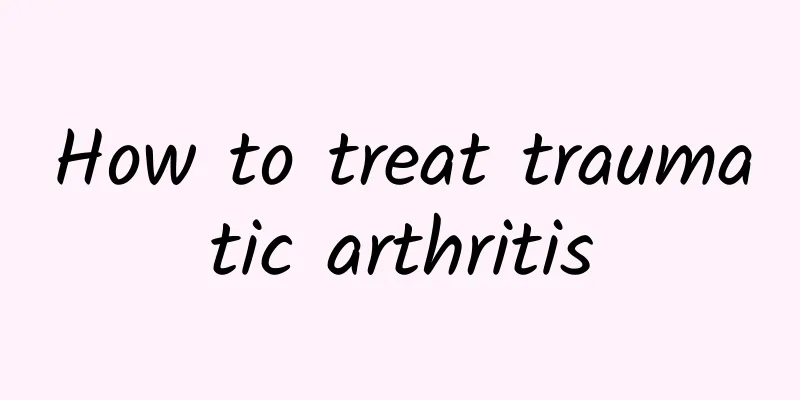How to treat traumatic arthritis

|
Traumatic arthritis is a common joint disease in our human body. Of course, this type of traumatic arthritis is also one of many types of arthritis. So, how to treat traumatic arthritis? In current medicine, there are still many methods for the treatment of traumatic arthritis, and these methods are relatively complete, so many patients with traumatic arthritis will choose to go to the hospital for treatment after suffering from traumatic arthritis. However, in reality, there are still many people who don’t know much about traumatic arthritis. Traumatic arthritis actually refers to symptoms such as key pain caused by injuries to certain parts of the body. This is called traumatic arthritis. So, let's talk about the specific treatment methods for traumatic arthritis. Treatment for traumatic arthritis includes: 1. Non-surgical treatment (1) Correct deformity and prevent articular cartilage degeneration. Traumatic arthritis is a late complication of fracture displacement and articular cartilage fracture, so the late deformity may be caused by malunion or developmental disorders after normal healing. One should be very familiar with the fracture sites and displacement patterns that are prone to malunion. For example, femoral trochanteric fractures and distal inward displacement cause hip varus deformity; tibial plateau fractures cause knee valgus (or valgus) deformity. The common feature of these common sites is that they are near the joint, but not all fractures near the joint are prone to complications such as malformation and late traumatic arthritis. (2) Drug treatment: Adjuvant drug treatment can alleviate symptoms. Commonly used anti-inflammatory and analgesic drugs in clinical practice include aspirin, which has analgesic and anti-inflammatory effects and is usually used in moderate doses. Other pain-relieving drugs include diclofenac sodium/misoprostol (Osmok), diclofenac (Voltaren), etc., which are effective in relieving symptoms. (3) Physical therapy refers to the physical changes in histamine, histamine-like substances, acetylcholine, temperature, ion concentration, etc. produced by human tissues under the influence of physical factors. It regulates the functions of the human body and causes biological, chemical and other changes, causing physiological effects in local tissues, thereby playing a therapeutic and preventive role. 2. Surgery (1) Joint cleaning is suitable for cases where there are loose bodies in the joint with obvious bone spurs at the edges, but the weight-bearing surface of the joint is relatively intact. (2) Osteotomy is suitable for patients with obvious genu valgum or genu valgum and obvious angular deformity of fracture healing. Osteotomy can reduce intra-bone pressure, correct the gravity line, and allow a relatively intact joint surface to bear more body weight load. (3) Obturator neurectomy is suitable for patients with hip pain but less damage to the joint surface. This is because the hip joint is innervated by the obturator nerve, femoral nerve, and sciatic nerve, while the adductor muscles are innervated by both the obturator nerve and femoral nerve. Therefore, removing the obturator nerve will not cause the hip joint to completely lose nerve control, nor will the adductor muscles be completely paralyzed. It can also significantly improve joint pain. (4) Arthrodesis is suitable for single lower limb weight-bearing joints with severe joint damage and for relatively young patients who need to walk or stand to work. (5) Arthroplasty is suitable for elderly people with severe pain and severe joint damage. Artificial joint replacement is more reliable. For example, central dislocation of the hip joint can cause fracture of the acetabulum base or femoral head cartilage, destroying the integrity of the hip joint. After healing, traumatic arthritis or traumatic avascular necrosis of the femoral head will form. If total hip replacement is not used, it will inevitably cause joint pain and dysfunction. Therefore, through the detailed introduction in the above article, I believe everyone now has a great understanding of the treatment methods of traumatic arthritis. After understanding, we will find that modern medicine has a variety of treatments for traumatic arthritis, and these treatments are also quite mature, so our patients with traumatic arthritis should go to the hospital for treatment in time. |
<<: Symptoms of frontotemporal dementia
>>: Precautions for cancer-related mental disorders
Recommend
What to do with early cataracts
Patients with early cataracts should pay attentio...
What to do if Qi and blood stagnation? Choosing the right treatment is key
Drug therapy, diet therapy and exercise therapy c...
What to do if you have a weak constitution and often catch a cold? Treatment of different types of colds
Colds are a very common disease in our daily live...
How to Eat Dried Deer Heart Blood
Maybe everyone has heard of deer blood and deer a...
What should I pay attention to after double eyelid surgery?
Right after having double eyelid surgery, you mus...
What are the fastest ways to enlarge your breasts through yoga?
Everyone wants to have a graceful figure. Practic...
The most obvious symptoms of abdominal infection
Postoperative incision infection is a very common...
How long after the curettage can I wash my hair and take a bath?
There are many issues that people need to pay att...
What causes back pain?
What causes low back pain? Many people are troubl...
Side effects and contraindications of leeches
Leeches are what we usually call leeches. They ar...
What to do if you have a sore throat after running?
The sore throat after running may be caused by th...
What causes protruding ear bones?
Some friends have protruding ear bones. Generally...
Can transient ischemic attack be cured?
There are many causes of transient cerebral ische...
What are the recipes for making wine with traditional Chinese medicine?
As the pace of life in modern society continues t...
How to determine if your baby has colic?
Colic is a common phenomenon in newborns. We all ...









